Book Title: Book Reviews Author(s): J W De Jong Publisher: J W De Jong View full book textPage 6
________________ BOOK REVIEWS signation pitamaha. The fact that this designation also occurs elsewhere makes it in any case highly unlikely that its use is due to a misunderstanding by the lady donor. Moreover, it is very doubtful that this inscription dates from the year 14 of the great Kaniska, cf. J. E. van Lohuizen-de Leeuw's detailed discussion of this inscription (The "Scythian." Period, Leiden, 1949, pp. 302-318). Even more surprising is Basham's interpretation of an inscription from Nagarjunikonda which was first edited by J. Ph. Vogel (Epigraphia Indica XX, 1929-30, pp. 16-17). This inscription records the erection of a pillar "for the attainment of welfare and happiness in both the worlds and in order to attain herself the bliss of Nirvana and for the attainment of welfare and happiness by all the world". (translation Vogel). Basham proposes to translate ubhaya-loka-hita-sukhavaha by "the bringing of welfare and joy to both families." According to him "if we take the phrase as meaning 'both worlds' the phrase sarva-loka-hita-sukhavaha seems pleonastic." One is at a complete loss to see how there can be a pleonasm because in the first case the word loka refers to this world and the hereafter and in the second case to mankind. Basham tries to justify his translation of loka as 'family' by referring to the meaning of log in several modern Indo-Aryan languages! The fact that in the very same inscription both families (ubhaya-kula) are mentioned is explained away by him as follows: "by ubhaya-loka santisri perhaps refers to the individual members of the two families, as distinct from the families taken collectively in ubhaya-kula." The meaning of the expression ubhaya-loka is obvious for anybody who has even the slightest acquaintance with Buddhist texts, in which so often mention is made of this world and the next. We must be grateful to Leslie S. Kawamura for having so carefully edited this volume which contains much interesting material on the Bodhisattva. It is a pity that no Buddhist scholar of repute has contributed a paper on the development of the Bodhisattva doctrine in India, but we must welcome the fact that this book contains three papers on Japan, because Japanese Buddhism has not yet received due attention from scholars outside Japan. Leslie S. Kawamura also deserves our gratitude for the excellent and detailed index which occupies more than thirty pages divided into two columns. J. W. DE JONG 151Page Navigation
1 ... 4 5 6
